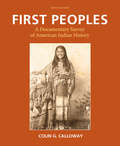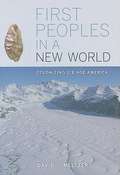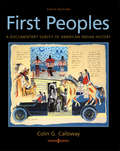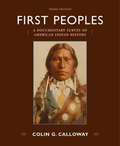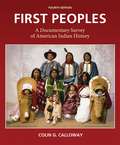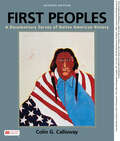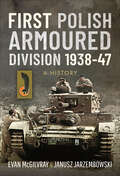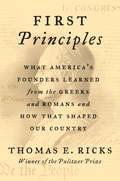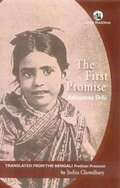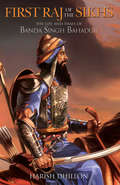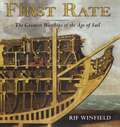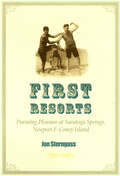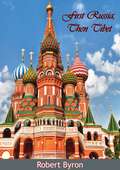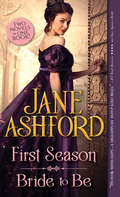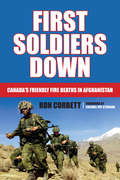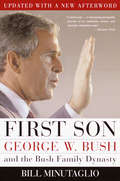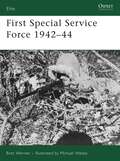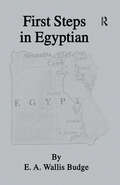- Table View
- List View
First Peoples
by Colin G. CallowayFirst Peoples was Bedford/St. Martin's first "docutext" - a textbook that features groups of primary source documents at the end of each chapter, essentially providing a reader in addition to the narrative textbook. Expertly authored by Colin G. Calloway, First Peoples has been praised for its inclusion of Native American sources and Calloway's concerted effort to weave Native perspectives throughout the narrative. First Peoples' distinctive approach continues to make it the bestselling and most highly acclaimed text for the American Indian history survey. Bedford Digital Collections for Native American History To give you more options for sources, we are offering five projects from the Bedford Digital Collections, bundled free with the purchase of a new text. This online repository of discovery-oriented projects offers both fresh and canonical sources ready to assign. Each curated project poses a historical question and guides students step by step through analysis of primary sources. Featuring: Pontiac's War, 1763-1765 Eric Hinderaker, University of Utah Building a Creek Nation: Reading the Letters of Alexander McGillivray Kathleen DuVal, University of North Carolina at Chapel Hill Debating Federal Indian Removal Policy in the 1830s John P. Bowes, Eastern Kentucky University Sand Creek: Battle or Massacre? Elliott West, University of Arkansas Fayetteville The Laguna Pueblo Baseball Game Controversy of the 1920s Flannery Burke, St. Louis University
First Peoples in a New World: Colonizing Ice Age America
by David J. MeltzerMore than 12,000 years ago, in one of the greatest triumphs of prehistory, humans colonized North America, a continent that was then truly a new world. Just when and how they did so has been one of the most perplexing and controversial questions in archaeology. This dazzling, cutting-edge synthesis, written for a wide audience by an archaeologist who has long been at the center of these debates, tells the scientific story of the first Americans: where they came from, when they arrived, and how they met the challenges of moving across the vast, unknown landscapes of Ice Age North America. David J. Meltzer pulls together the latest ideas from archaeology, geology, linguistics, skeletal biology, genetics, and other fields to trace the breakthroughs that have revolutionized our understanding in recent years. Among many other topics, he explores disputes over the hemisphere's oldest and most controversial sites and considers how the first Americans coped with changing global climates. He also confronts some radical claims: that the Americas were colonized from Ice Age Europe or that a crashing comet obliterated the Pleistocene megafauna and nearly wiped out people as well. Full of entertaining descriptions of on-site encounters, personalities, and controversies, this is a compelling behind-the-scenes account of how science is illuminating our past.
First Peoples: A Documentary Survey of American Indian History
by Colin CallowayExpertly authored by Colin G. Calloway, First Peoples has been praised for its inclusion of Native American sources and Calloway’s concerted effort to weave Native perspectives throughout the narrative. Emphasizing the importance of primary sources, each chapter includes a document project and picture essay organized around important themes in the chapter. This distinctive approach continues to make First Peoples the bestselling and most highly acclaimed text for the American Indian history survey.
First Peoples: A Documentary Survey of American Indian History
by Colin G. CallowayA survey of the Native tribes in America from before colonization to present times.
First Peoples: A Documentary Survey of American Indian History
by Colin G. Calloway"First Peoples" distinctive approach to American Indian history has earned praise and admiration from its users. Created to fill the significant need for a survey text that acknowledges the diversity of Native peoples, respected scholar Colin G. Calloway provides a solid course foundation that still allows instructors to emphasize selected topics of interest to them and their students. The signature format of "First Peoples" strikes the ideal balance between primary and secondary source material, combining narrative, written documents, and visual documents in each chapter.
First Peoples: A Documentary Survey of American Indian History
by Colin G. CallowayFirst Peoples' distinctive approach continues to make it the bestselling and most highly acclaimed text for the American Indian history survey. Respected scholar Colin G. Calloway provides a solid foundation grounded in timely scholarship and a narrative that brings a largely untold history to students. The signature "docutext" format of First Peoples strikes the ideal balance, combining in every chapter a compelling narrative and rich written and visual documents from Native and non-Native voices alike. An expansion by two full chapters presents a more diverse and nuanced picture of the history of Native peoples in America.
First Peoples: A Documentary Survey of Native American History
by Colin CallowayCalloway, First Peoples is the best-selling and most respected Native American history textbook. The text features a rich collection of primary source documents along with an easy-to-read narrative and plentiful assessments and tools in Achieve to support learning.
First Person: A Biography of Cairine Wilson Canada's First Woman Senator
by Valerie KnowlesCairine Wilson, Canada’s first female senator, was one of nine children raised in an atmosphere of rugged Scots liberalism and strict presbyterianism by affluent Montreal parents in the late nineteenth century. She displayed an interest in politics early in life and through her father’s position in the Senate, was befriended by many notable politicians of the period, including Sir Wilfrid Laurier, an experience that left a permanent mark on her. Her appointment to the Senate in 1930 was a historic and controversial event, and launched a political career rife with passion, commitment, and reform. Wilson, whose work on behalf of refugees and the world’s needy was legendary, served in the Senate through some of the stormiest years in Canadian government history. First Person is an engaging account of a colourful and powerful politician; a fighter whose efforts were recognized by the highest officials in the land, and whose sculpted image adorns the foyer of the Canadian Senate.
First Platoon: A Story of Modern War in the Age of Identity Dominance
by Annie JacobsenAn urgent investigation into warfare, good, and evil in the age of biometrics, the technology that would allow the government to identify anyone, anywhere, at any time This is a story that starts off close and goes very big. The initial part of the story might sound familiar at first: It is about a platoon of mostly nineteen-year-old boys sent to Afghanistan, and an experience that ends abruptly in catastrophe. Their part of the story folds into the next: inexorably linked to those soldiers and never comprehensively reported before is the U.S. Department of Defense&’s quest to build the world&’s most powerful biometrics database, with the power to identify, monitor, catalogue, and police people all over the world. First Platoon is an American saga that illuminates a transformation of society made possible by this new technology. Part war story, part legal drama, it is about identity in the age of identification. About humanity—physical bravery, trauma, PTSD, a yearning to do right and good—in the age of biometrics, which reduce people to iris scans, fingerprint scans, voice patterning, detection by odor, gait, and more. And about the power of point-of-view in a burgeoning surveillance state. Based on hundreds of formerly classified documents, FOIA requests, and exclusive interviews, First Platoon is an investigative exposé by a master chronicler of government secrets. First Platoon reveals a post–9/11 Pentagon whose identification machines have grown more capable than the humans who must make sense of them. A Pentagon so powerful it can cover up its own internal mistakes in pursuit of endless wars. And a people at its mercy, in its last moments before a fundamental change so complete it might be impossible to take back.
First Polish Armoured Division 1938–47: A History
by Evan McGilvray Janusz JarzembowskiThe First Polish armored Division was formed in Scotland in February 1942 from Polish exiles who had escaped first Poland and then France. Its commander, Stanislaw Maczek, and many of its men had previously served in Polish 10th Motorized Cavalry Brigade (10 BKS), which had taken part in the Polish invasion of Czechoslovakia in 1938 and given a good account of itself in the defense of Poland against German and Soviet invasion of 1939. Under Maczek’s leadership the division was trained and equipped along British lines in preparation for the invasion of France. Attached to 1st Canadian Army, the division was sent to Normandy in late July 1944. It suffered heavily during Operation Totalize but went on to play a crucial role in preventing an orderly German withdrawal from the Falaise Pocket by its stand at Hill 262. They then played their part in the advance across Western Europe and into Germany. This detailed history, supported by dozens of archive photos, concludes by looking at the often-poor treatment of Maczek and his men after the war.
First Principles: What America's Founders Learned from the Greeks and Romans and How That Shaped Our Country
by Thomas E. RicksThe Pulitzer Prize-winning journalist and #1 New York Times bestselling author offers a revelatory new book about the founding fathers, examining their educations and, in particular, their devotion to the ancient Greek and Roman classics—and how that influence would shape their ideals and the new American nation. <p><p> On the morning after the 2016 presidential election, Thomas Ricks awoke with a few questions on his mind: What kind of nation did we now have? Is it what was designed or intended by the nation’s founders? Trying to get as close to the source as he could, Ricks decided to go back and read the philosophy and literature that shaped the founders’ thinking, and the letters they wrote to each other debating these crucial works—among them the Iliad, Plutarch’s Lives, and the works of Xenophon, Epicurus, Aristotle, Cato, and Cicero. For though much attention has been paid the influence of English political philosophers, like John Locke, closer to their own era, the founders were far more immersed in the literature of the ancient world. <p> The first four American presidents came to their classical knowledge differently. Washington absorbed it mainly from the elite culture of his day; Adams from the laws and rhetoric of Rome; Jefferson immersed himself in classical philosophy, especially Epicureanism; and Madison, both a groundbreaking researcher and a deft politician, spent years studying the ancient world like a political scientist. Each of their experiences, and distinctive learning, played an essential role in the formation of the United States. In examining how and what they studied, looking at them in the unusual light of the classical world, Ricks is able to draw arresting and fresh portraits of men we thought we knew. <p> First Principles follows these four members of the Revolutionary generation from their youths to their adult lives, as they grappled with questions of independence, and forming and keeping a new nation. In doing so, Ricks interprets not only the effect of the ancient world on each man, and how that shaped our constitution and government, but offers startling new insights into these legendary leaders. <p> <b>A New York Times Bestseller</b>
First Promise
by Ashapurna Debi Indira ChowdhuryIn a deceptively easy, conversational style, through episodes that sketch out the rituals, the quarrels and predicaments of women's lives, a compelling story emerges upon the landscapes of rural Bengal and colonial Calcutta.
First Raj of the Sikhs: The Life and Times of Banda Singh Bahadur
by Harish DhillonBanda Singh Bahadur appeared in Sikh history for a relatively short period (1708-1716) but, after the Sikh gurus, influenced it more significantly than any other individual. Banda Singh Bahadur is among the most colourful and fascinating characters in Sikh history. From an ascetic he was transformed into Guru Gobind Singh’s most trusted disciple. So much so that when the seriously injured guru could not lead his Sikh army against the Mughal forces, he appointed Banda Singh Bahadur as his deputy. As proof of this appointment he gave Banda his sword, a mighty bow, arrows from his own quiver, his battle standard and his war drum. Banda rode out from Nanded (where Guru Gobind Singh passed away; now in Maharashtra) at the head of a small band of Sikhs, which, by the time it reached the Punjab, had grown into a formidable army. Over the next few years his exploits against the Mughal rulers, both in pitched battles and in skirmishes, became the stuff of legends. He became the first of many legendary Sikh generals, famous both for their personal heroic courage and their skill in warfare. His many encounters with the Mughal rulers eroded the very foundation of the Mughal empire and ensured its quick demise. As he said when questioned on what he had achieved: ‘I have ensured that never again will the crown sit easily on the Mughal emperor’s head.’ He also prepared the coming generations of Sikhs for future conflicts, which later greatly helped Maharaja Ranjit Singh in creating a Sikh empire. Banda was a true leader who led from the front, not only in the battlefield but also in civil administration. He established a secular government which swept aside 700 years of slavery and the myth of domination by foreign powers, proclaimed freedom of worship, allowed the people to follow professions of their choice and stopped forcible marriages even while recovering abducted women for return to their families. His land revolution abolished zamindari in parts of North India, thereby redistributing land equally amongst the tillers. This book seeks to tell the story of this remarkable and brave man and his equally remarkable ahievements. Perhaps, the finest of Banda Singh Bahadur’s biographies.
First Rate: The Greatest Warships in the Age of Sail
by Rif WinfieldIn the sailing era First Rates were the largest, most powerful and most costly ships to construct, maintain and operate. Built to the highest standards, they were lavishly decorated and given carefully considered names that reflected the pride and prestige of their country. They were the very embodiment of national power, and as such drew the attention of artists, engravers and printmakers. This means that virtually every British First Rate from the Prince Royal of 1610 to the end of sail is represented by an array of paintings, drawings, models or plans.This book is a celebration of these magnificent ships, combining an authoritative history of their development with reproductions of many of the best (and least familiar) images of the ships, chosen for their accuracy, detail and sheer visual power in an extra-large format that does full justice to the images themselves. It also includes comparative data on similar vessels in other navies, so it is a book that everyone with an interest in wooden warships will find both enlightening and a pleasure to peruse.
First Resorts: Pursuing Pleasure at Saratoga Springs, Newport & Coney Island
by Jon Sterngass“[A] scrupulously researched and beautifully crafted account of how nineteenth-century Americans went in search of health, rest, and diversion.” —Lena Lencek and Gideon Bosker, coauthors of The Beach. The History of Paradise on EarthIn First Resorts: Pursuing Pleasure at Saratoga Springs, Newport, and Coney Island, Jon Sterngass follows three of the best-known northeastern American resorts across a century of change. Saratoga Springs, Newport, and Coney Island began, he finds, as similar pleasure destinations, each of them featuring “grand” hotels where visitors swarmed public spaces such as verandas, dining rooms, and parlors. As the century progressed, however, Saratoga remained much the same, while Newport turned to private (and lavish) “cottages” and Coney Island shifted its focus to amusements for the masses.Fifty-nine illustrations enliven Sterngass’s unique study of the commodification of pleasure that occurred as capitalist values flourished, travel grew more accessible, and leisure time became democratized. These three resorts, he argues, served as forerunners of twentieth-century pleasure cities such as Aspen, Las Vegas, and Orlando.“An engaging, creative book replete with evocative illustrations and witty quotes . . . a pleasant read.” —Thomas A. Chambers, New York Academy of History“Sterngass’s discussions about privacy, community, commercialization, consumption, leisure, and the desire to be conspicuous are important and new. With its well-chosen illustrations, this is a handsome book as well as an important one.” —Kathryn Allamong Jacob, Radcliffe Institute for Advanced Study, Harvard University“Having mined every conceivable source about his three sites, Sterngass has presented a wealth of interesting material not only about the resort experience but also about the residents, politicians, and entrepreneurs who built them.” —Journal of American History
First Resorts: Pursuing Pleasure at Saratoga Springs, Newport, and Coney Island
by Jon SterngassThis history of Saratoga Springs, Newport, and Coney Island explores the cultural and social forces that shaped tourism, defined leisure, and developed these places into the diverse vacation spots we know today."At the dawn of the nineteenth century, Saratoga Springs hosted no more than a thousand hardy travelers yearly, Newport floundered in the midst of a fifty-year commercial decline, and Coney Island's beach resembled a wind-swept wilderness. A hundred years later, the number of summer visitors to Saratoga had increased a hundredfold, the antics of high society at Newport transfixed America, and at least five million pleasure seekers visited Coney annually. 'Those who talk of the mushroom growth of our Western cities,' declared an astounded writer for Harper's Weekly in 1878, 'might better spend their wonder and enthusiasm upon our Eastern watering-place.'"—From the IntroductionIn First Resorts: Pursuing Pleasure at Saratoga Springs, Newport, and Coney Island, Jon Sterngass follows three of the best-known northeastern American resorts across a century of change. Saratoga Springs, Newport, and Coney Island began, he finds, as similar pleasure destinations, each of them featuring "grand" hotels where visitors swarmed public spaces such as verandas, dining rooms, and parlors. As the century progressed, however, Saratoga remained much the same, while Newport turned to private (and lavish) "cottages" and Coney Island shifted its focus to amusements for the masses. Fifty-nine illustrations enliven Sterngass's unique study of the commodification of pleasure that occurred as capitalist values flourished, travel grew more accessible, and leisure time became democratized. These three resorts, he argues, served as forerunners of twentieth-century pleasure cities such as Aspen, Las Vegas, and Orlando.
First Responders: Inside the U.S. Strategy for Fighting the 2007-2009 Global Financial Crisis
by Henry M. Paulson Jr. Ben S. Bernanke Timothy F. Geithner J. Nellie LiangAn insider’s view of the U.S. government’s response to the 2007–2009 global financial crisis, as recounted by the people who made the key decisions In 2008, the world’s financial system stood on the brink of disaster. The United States faced an unprecedented crisis when the investment bank Lehman Brothers collapsed, setting off a global panic. Faced with the prospect of a new Great Depression, the Treasury Department, the Federal Reserve, the Federal Deposit Insurance Corporation, and other agencies took extraordinary measures to contain the damage and steady the financial system and the economy. Edited by three of the policymakers who led the government’s response to the crisis, with chapters written by the teams tasked with finding policy solutions, this book provides a comprehensive accounting of the internal debates and controversies surrounding the measures that were taken to stabilize the financial system and the economy. Offering previously untold insight into the key choices (including rejected options) and a frank evaluation of successes and failures, this volume is both an important historical document and an indispensable guide for confronting future financial calamities.
First Russia, Then Tibet [Illustrated Edition]
by Robert ByronOver the course of several months during 1931 and 1932, Robert Byron journeyed to three countries teetering on the brink of change.In Russia, which was stricken by famine, Lenin had just died, Stalin's dictatorship was in its infancy and the Great Terror had yet to begin. Having taken the first commercial flight to India, which took an astounding seven days, Byron was thrown into the tumultuous last years of the British Raj. Gandhi was imprisoned, while rioting and clashes between Hindus and Muslims had become commonplace. Finally Byron entered Tibet, the forbidden country. Exploring "The Land of Snows", he saw Tibet as it was when the then Dalai Lama was still ensconced in the Potala Palace, twenty years before China's invasion.First Russia, Then Tibet is an invaluable first-hand account of transformative moments in periods of change and upheaval.-Print ed.Richly illustrated throughout.
First SEALs: The Untold Story of the Forging of America's Most Elite Unit
by Patrick K. O'DonnellFrom bestselling author Patrick K. O'Donnell, the untold story of World War II's first unit of special operations combat swimmers-precursors of today's US Navy SEALs
First Season / Bride to Be
by Jane AshfordTwo classic Regency romances by beloved bestselling author Jane Ashford celebrate the adventures of a London SeasonFIRST SEASONWidowed Lady Anabel Wyndham was married right out of the schoolroom and has never before experienced the delights of a London Season. She's dazzled by the attention of the fascinating Sir Charles Norbury, a man whose touch seems to melt her very soul, but a notorious rake. She's drawn to handsome friend-of-the-family Christopher Hanford and the comfort and serenity he offers. But how does one choose between two such charming suitors? Anabel is finding that love is so much more dangerous the second time around.BRIDE TO BEEmily Crane is the toast of the ton-and she couldn't find it more tedious. Until she encounters the darkly sensual stranger whose life she once saved and the London Season becomes infinitely more exciting. Recently returned from the wilds of South America, Lord Richard Sheldon has only contempt for tiresome London chits, but he finds himself stunningly intrigued by the dauntless Emily Crane. When the two become embroiled in a budding scandal and are forced into an engagement, they discover a passion more dangerous than any killer...Praise for The Bride Insists: "Another perfectly delightful Regency romance...remarkably executed." -Publishers Weekly, Starred Review "Ashford captures readers with her keen knowledge of the era and deft writing." -RT Book Reviews, 4 stars"Fabulous...well-written, great characters." -Fresh Fiction
First Snow, Last Light
by Wayne JohnstonFrom the author of the critically acclaimed, prizewinning and internationally bestselling The Colony of Unrequited Dreams comes an epic family mystery with a powerful, surprise ending, which features the return of the ever-fascinating Sheilagh Fielding, one of the most memorable characters in fiction.Ned Vatcher, only 14, ambles home from school in the chill hush that precedes the first storm of the winter of 1936 to find the house locked, the family car missing, and his parents gone without a trace. From that point on, his life is driven by the need to find out what happened to the Vanished Vatchers. His father, Edgar, born to a poor family of fishermen, had risen to become the right-hand man to the colony's prime minister, then suffered an unexpected fall from grace. Were he and his wife murdered? Was it suicide? Had they run away? If so, why had they left their only child behind? Ned soon finds himself enmeshed in another family, that of his missing father and the poverty from which the man somehow escaped. His grandparents, Nan and Reg, his Uncle Cyril and others, are themselves haunted by the inexplicable disappearance of a third Vatcher, a young man who was lost at sea on a calm and sunny day years earlier. Two other people loom large as Ned becomes Newfoundland's first media mogul, building an empire to insulate him from loss: a Jesuit priest named Father Duggan, and Sheilagh Fielding, a boozy giantess who, while wandering the city streets at night, composes satiric columns that scandalize the rich and powerful. In Ned, Fielding sees a surrogate for her two lost children, the secret that dogs her life, while Ned believes the enigmatic Fielding to be his soulmate. The novel builds to a spectacular resolution of the mystery of all the Vanished Vatchers. Only Wayne Johnston could create such larger-than-life, mythic characters embroiled in events that leave us contemplating not only their tragedies and triumphs, but the forces that compel us all to act in ways that surprise and sometimes terrify us.
First Soldiers Down: Canada's Friendly Fire Deaths in Afghanistan
by Ron Corbett Colonel Pat StogranOn April 18, 2002, "friendly fire" killed four Canadian soldiers in Afghanistan, Canada’s first combat deaths since the Korean War. On April 18, 2002, Alpha Company, Third Battalion of the Princess Patricia’s Canadian Light Infantry, was on a training exercise at Tarnak Farms, a former Taliban artillery range in southern Afghanistan. The exercise had been underway for nearly seven hours when two American fighter pilots flew overhead. One, Major Harry Schmidt, saw the artillery fire below, and thinking he was under attack, dropped a laser-guided bomb.Four Canadian soldiers died that night, the first Canadian combat fatalities since the Korean War. For many in Canada the tragedy signalled the true beginning of Canada’s lengthy combat mission in Afghanistan.First Soldiers Down recounts what happened that evening through archival material and the recollections of troops. It also tells the personal stories of the fallen Sergeant Marc Lger, Corporal Ainsworth Dyer, Private Richard Green, and Private Nathan Smith as well as what happened to the loved ones of each of the four in the decade since the incident.
First Son: George W. Bush and the Bush Family Dynasty
by Bill MinutaglioMinutaglio, a Texas journalist who has worked for some of the state's major newspapers, tells the story of a powerful political family, beginning with the turn-of-the-century emergence of the influential Bush-Walker clan and of Prescott Bush, the Connecticut patrician who ingrained in his family an ethos that continues to exert influence on his son, former President George Bush, and his grandsons Jeb and George W. Bush. How these scions of the Bush dynasty struggle to live up to their legacy is the cen...
First Special Service Force 1942-44
by Michael Welply Bret WernerThis is a concise history of the unique integrated commando-style brigade of US and Canadian volunteers formed in 1942. Hand picked, and trained in airborne, amphibious, mountain and winter warfare, demolitions and close-quarter tactics, they left a combat legacy still recognized amongst today's Special Forces. This book explores the remarkable results the FSSF achieved in Italy - in the harsh mountain fighting on the Winter Line, in the trenches of Anzio, and in the breakthrough to Rome. Accompanied by unique combat photography and illustrations of their distinctive uniforms, this is an insight into a famous, but little explored unit.
First Steps In Egyptian: A Book For Beginners (Egypt Ser.)
by BudgeFirst published in 2005. Routledge is an imprint of Taylor & Francis, an informa company.
